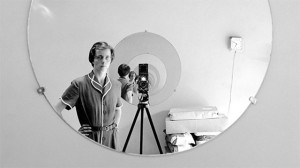Is an artist’s life relevant to her reputation as an artist? Not so much, perhaps, but many of us want the bio anyway, especially when the artist in question is as tantalizingly elusive as Vivian Maier (or Mayer, or Meyer, as she variously spelled it to confound the curious), a reclusive Chicago nanny whose posthumously discovered trove of street photographs swelled into a cause celebre after her death in 2009.
The lucky, sharp-eyed finder of the stash was John Maloof, a photographer and flea market regular who paid $340 for more than 100,000 mostly undeveloped negatives while researching a local history project. He must be a lot richer now, but having tried to persuade initially indifferent art museums to exhibit Maier’s work, Maloof and his co-director Charlie Siskel (a nephew of the late film critic Gene Siskel) set out to learn what they could about a woman who seemed to have no interest in sharing her work, still less in courting public recognition.
The resulting documentary, Finding Vivian Maier, might better have been titled Constructing Vivian Maier — not because the filmmakers came up empty-handed, but because what they found out sheds too neat and tidy a light on her unsparing, yet warmly sympathetic portraits of the denizens of Chicago’s seamy underside.
From Web research and interviews with Maier’s employers and former charges (some of whom, fancifully or not, claim friendship with her), Maloof learned that though she was born in New York in 1926, Maier affected a “fake” French accent. Then again, her mother was French and she spent chunks of time in the Alsatian village where her mother grew up. Her father barely enters the picture, which may or may not have anything to do with her reported antagonism toward or fear of men and the fact that she never married or, apparently, had an intimate relationship with a man.

9(MDAxOTAwOTE4MDEyMTkxMDAzNjczZDljZA004))

